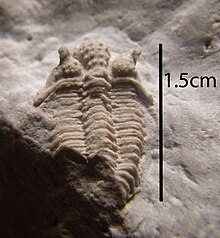| Encrinuridae Temporal range: Middle Ordovician–Early Devonian PreꞒ Ꞓ O S D C P T J K Pg N | |
|---|---|

| |
| Fossil of Encrinurus egani from the Racine Dolomite | |
| Scientific classification | |
| Domain: | Eukaryota |
| Kingdom: | Animalia |
| Phylum: | Arthropoda |
| Class: | †Trilobita |
| Order: | †Phacopida |
| Family: | †Encrinuridae Angelin, 1854 |
Encrinuridae is a family of trilobite within the order Phacopida that lived in what would be Africa, Asia, Australia, Europe, North America, and South America from the middle Ordovician to the early Devonian from 479 to 412.3 million years ago, existing for approximately 66.7 million years.
Taxonomy
Encrinuridae was named by Angelin (1854). It was assigned to Phacopida by Gregory Edgecombe (1994). It contains the following genera:
- †Aegrotocatellus
- †Alwynulus
- †Atractocybeloides
- †Atractopyge
- †Avalanchurus
- †Balizoma
- †Batocara
- †Bevanopsis
- †Billevittia
- †Brianurus
- †Celtencrinurus
- †Coronaspis
- †Coronocephalus
- †Cromus
- †Curriella
- †Cybele
- †Cybeloides
- †Cybelurus
- †Dayongia
- †Deacybele
- †Dindymene
- †Distyrax
- †Dnestrovites
- †Elsarella
- †Encrinuroides
- †Encrinurus
- †Eodindymene
- †Erratencrinurus
- †Fragiscutum
- †Frammia
- †Frencrinuroides
- †Johntempleia
- †Kailia
- †Koksorenus
- †Langgonia
- †Lasaguaditas
- †Libertella
- †Lyrapyge
- †Mackenziurus
- †Mitchellaspis
- †Nucleurus
- †Oedicybele
- †Paracybeloides
- †Paraencrinurus
- †Parakailia
- †Perirehaedulus
- †Perryus
- †Physemataspis
- †Plasiaspis
- †Prophysemataspis
- †Prostrix
- †Rielaspis
- †Rongxiella
- †Sinocybele
- †Staurocephalus
- †Stiktocybele
- †Struszia
- †Tewonia
- †Walencrinuroides
- †Wallacia
Fossil distribution
Fossils were found in strata dating from the Arenig to Lochkovian ages. Locations were varied and stretched from Florentine Valley, Tasmania to Xinjiang Province, China to Will County, Illinois.
Sources
- PaleoBiology Database: Encrinuridae, basic info
- Edgecombe, Gregory D. (1994). "New Lower Silurian (Llandovery) encrinurine trilobites from the Mackenzie Mountains, Canada". Journal of Paleontology. 68 (4): 824–837. Bibcode:1994JPal...68..824E. doi:10.1017/S0022336000026263. JSTOR 1306150. S2CID 132373442.
- S. M. Gon III. "Order Phacopida". Retrieved November 21, 2010.
- Fossils (Smithsonian Handbooks) by David Ward
- Trilobites by Riccardo Levi-Setti
- Invertebrate Palaeontology and Evolution by E.N.K. Clarkson
- Trilobites: Common Trilobites of North America (A NatureGuide book) by Jasper Burns
External links
- Encrinurus in the Paleobiology Database
| Taxon identifiers | |
|---|---|
| Encrinuridae |
|
This Phacopida-related article is a stub. You can help Misplaced Pages by expanding it. |